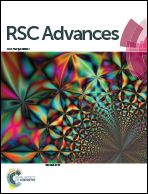Use of multifunctional phosphorylated PAMAM dendrimers for dentin biomimetic remineralization and dentinal tubule occlusion
Abstract
The disequilibrium between demineralization and remineralization of teeth, especially of dentin, may lead to serious consequences like dental caries that are considered to affect people's quality of life. The employment of biomimetic analogs of proteins to duplicate biomineralization, which is a well-regulated process mediated by extracellular matrix proteins, may provide new insights to solve these problems. Here we report the use of a modified multifunctional dendrimer, synthesized by the introduction of phosphate groups via a Mannich-type reaction onto poly(amidoamine) (PAMAM) dendrimers, to biomimetically remineralize dentin. The phosphorylated PAMAM dendrimers were demonstrated to act, along with an amorphous calcium phosphate stabilizing agent, polyacrylic acid (PAA), as biomimetic analogs of noncollagenous proteins to induce the remineralization of demineralized dentin. Phosphorylated PAMAM dendrimers treated demineralized dentin discs were immersed in a remineralizing solution containing PAA for up to 7 days. The success of this remineralization was examined using attenuated total reflection Fourier-transform infrared spectroscopy (ATR-FTIR), X-ray diffraction (XRD), energy-dispersive X-ray spectroscopy (EDS) and electron microscopy. These results showed that demineralized dentinal collagen fibrils were successfully phosphorylated by the treatment of phosphorylated PAMAM dendrimers and embedded with calcium-deficient hydroxyapatite after remineralization. The surfaces of demineralized dentin discs were covered with newly induced crystals and the patent dentinal tubules were occluded. A good biocompatibility was also determined. Thus, phosphorylated PAMAM dendrimers could be applied as a minimally invasive method of management of dentin caries, employed to improve the resin–dentin bonding stability and also be used in the treatment of dentin hypersensitivity.


 Please wait while we load your content...
Please wait while we load your content...